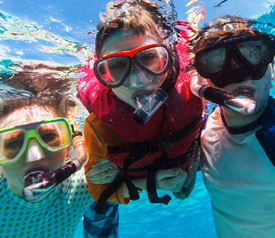
An ileostomy should not prevent you from snorkeling or scuba diving. With the correct materials and some planning a day at the beach can be issue free and fun. That being said, everyone is different. A pouch may adhere differently from person to person, but the many product manufacturers do take water into consideration when designing their products.
Some Things to Consider Before & After a Trip to the Pool or Beach
- There are wraps and swim wear that can help secure a pouch for added securement. There are companies that make swimwear for ostomates.
- It is a good idea to empty your pouch before swimming.
- If you irrigate, do so prior to entering the water.
- Many with a one piece system recommend that the wafer be affixed to the skin a few hours before submerging water. Some recommend longer periods of time (UOAA recommends 12 hours) if no secondary adhesive or tape is being used.
- To avoid irritated skin it is wise to dry your baseplate.
- Secure the baseplate with waterproof tape. We hear from many that our 1.5” or 2” tape provides enough hold on the body and wafer to keep it in place.
- Always carry extra supplies in case you are somewhere where supplies may not be available.
Scuba Diving with an Ostomy or Ileostomy
Scuba Diving with a stoma and pouching system is similar in many regards to the above advice for swimming and snorkeling. Some may be concerned when the increased water pressure causes the gas in the pouch to compress. The increased pressure should not cause any breach or issues with your pouching system. Like your body the pouch will return to normal as you return to the surface. The increased pressure may cause your pouch to fill quicker. If is always a good idea to plan your meals accordingly to limit volume. Being hydrated is always important, but even more so while diving.
If diving with a wet suite, some advise that a stoma guard be used to help avoid pancaking and having the pouch lift. While the wet suit keeps the bag in a better position throughout the dive, it can also restrict the escape of gas into the bag. A lead belt may put pressure on your pouching system depending on location. Some prefer to place the lead in the pockets of the diving vest or on the tank.

